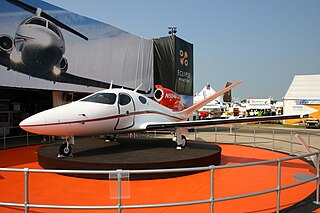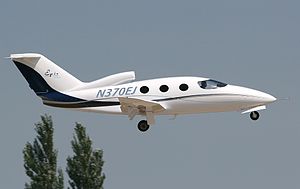The FF-1080 is an aircraft design by Utilicraft Aerospace Industries of Albuquerque, New Mexico, USA, for a twin turboprop aircraft fitted to carry LD3 aircraft cargo containers between large airports and smaller airports.

The Piper PA-46 Malibu and Matrix are a family of American light aircraft manufactured by Piper Aircraft of Vero Beach, Florida. The aircraft is powered by a single engine and has the capacity for one pilot and five passengers. Early Malibus were all piston-engined, but a turboprop version, introduced as the Malibu Meridian but now called the M500, is also available. Currently, Piper offers the M350, M500, and M600 in the PA-46 family.

The Comp Air Jet is an American eight-seat, low-wing, pressurized, tricycle undercarriage, turbofan-powered civil utility aircraft marketed by Comp Air for amateur construction.

The Hawker 4000, originally known as the Hawker Horizon, is a super-midsize business jet developed by Hawker Beechcraft.

The Williams V-Jet II was designed and built by Burt Rutan's Scaled Composites for Williams International as a test bed and demonstrator aircraft for Williams' new FJX-1 turbofan engine.

The Cirrus Vision SF50, also known as the Vision Jet, is a single-engine very light jet designed and produced by Cirrus Aircraft of Duluth, Minnesota, United States.

The Saunders ST-27 was a regional aircraft built in the 1970s by the Canadian Saunders Aircraft Company based at Gimli, Manitoba. The aircraft was designed as a conversion of the earlier de Havilland Heron. The conversion program was extensive and featured two Pratt & Whitney Canada PT6 turboprops and a stretched fuselage. Despite its promise as a regional airliner, the project collapsed when Manitoba government funding was withdrawn in 1976.

The Dassault Falcon 2000 is a French business jet and a member of Dassault Aviation's Falcon business jet line, and is a twin-engine, slightly smaller development of the Falcon 900 trijet, with transcontinental range.

The Eclipse 400 is a single-engine very light jet that was designed by Eclipse Aviation of Albuquerque, New Mexico.

The Cessna Citation Columbus was a business jet project by Cessna, part of the Cessna Citation family. The Model 850 was launched in February 2008 and cancelled in July 2009. It would have been the largest model of the family at the time. Powered by 8,830 lbf PW810 turbofans and a 4,000 nmi (7,400 km) range, the $27 million aircraft had a 709 sq ft, 30° swept wing.

The Foxjet ST600 was a small business jet under development in the United States in the late 1970s. Problems with development, particularly in finding a suitable powerplant, caused the project to be abandoned before any substantial work on the prototype had been done, but the concept proved to be ahead of its time, foreshadowing the very light jets of thirty years later.

The Xian MA600 is an improved version of the Xian MA60 manufactured by the Xi'an Aircraft Industry Corporation under the Aviation Industry Corporation of China (AVIC).
The Xian MA700 is a twin-engine, medium-range turboprop airliner currently under development by Xi'an Aircraft Industrial Corporation of the Aviation Industry Corporation of China (AVIC).

The Epic LT is an American kit-built single-engined turboprop aircraft intended for use by private pilots. The Epic Dynasty was the proposed certified version of the LT that was intended be sold as a completed aircraft, prior to Epic Aircraft's bankruptcy in August 2009 and later acquisition by new owners in April 2010. Under ownership of the reorganized company, the certificated version is to be called the E1000, with first deliveries initially scheduled for 2015, but delayed until 2019.

The Hamilton H-45 and H-47 were six-passenger-seat, all-metal, high-wing monoplanes powered by single Pratt & Whitney radial engines. They were built for passenger and mail-carrying work in the US in the late 1920s.

The Cessna Citation Sovereign is an American business jet developed by Cessna, part of the Cessna Citation family. Announced at the 1998 NBAA convention, the Model 680 made its maiden flight in February 2002, certification was awarded on June 2, 2004, and deliveries began in late September. The Citation Excel fuselage was stretched and joined with an all-new, larger wing and more powerful Pratt & Whitney Canada PW306C engines for increased maximum takeoff weight and a 3,200 nmi (5,900 km) range. The improved Sovereign+ was announced at the October 2012 NBAA for a first flight in April 2013 and deliveries in December, with added winglets and an improved flight deck and engines.

The Eclipse 550 is a very light jet initially built by Eclipse Aerospace and later One Aviation of Albuquerque, New Mexico, United States. The aircraft is a development version of the Eclipse 500, which was produced by predecessor Eclipse Aviation. Like the 500, the 550 is a low-wing, six seat, twin engine jet-powered aircraft. The Eclipse 550 is certified for single-pilot operation.

The SubSonex is an experimental, single-place, amateur-built jet from Sonex Aircraft's "Hornet's Nest" development division. The aircraft is often referred to in the industry as a "microjet".

The Cessna Citation Latitude is a business jet built by Cessna. The Model 680A was announced at the 2011 NBAA convention, the prototype first flew on 18 February 2014, it achieved FAA certification on June 5, 2015, and first deliveries began on August 27. It keeps the Model 680 Sovereign wing, twin P&WC PW306D turbofans and cruciform tail for a 2,700 nmi (5,000 km) range. Its new stand-up circular fuselage has a flat floor and was kept in the later Cessna Citation Longitude.
The Stratos 714 is an American very light jet aircraft under development by Stratos Aircraft of Redmond, Oregon. The project was announced in July 2008, a prototype first flew on 21 November 2016, although Stratos currently lacks the funding to complete type certification. Predominantly made of carbon composite, the single turbofan aircraft would seat four to six at 400 kn (740 km/h) over up to 1,500 nmi (2,800 km).



















